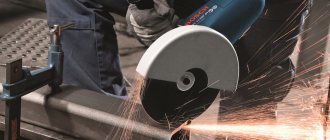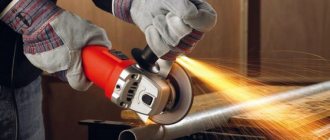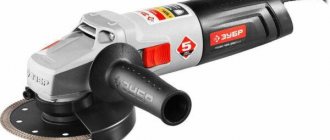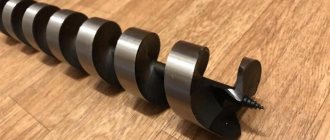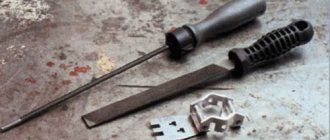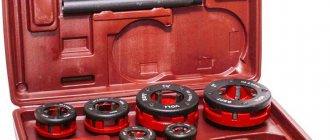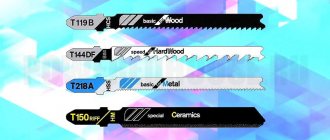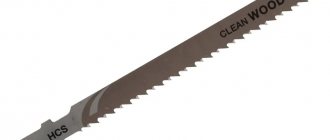What is the correct name for a grinder?
The familiar name - Bulgarian - is so common that few people remember why it is called that.
This tool is properly called an angle grinder (angle grinder). Initially it was intended for processing internal corners at the junctions of two floors. The first copies of such machines arrived in the Soviet Union from then-friendly Bulgaria, where they were produced. According to the custom of people, they tried to shorten the long and awkward name. As a result, a new word has firmly entered into everyday use - Bulgarian.
Sometimes manufacturers use the SHMU (angle grinder) or LMU variant.
Gradually, all power tools that looked like the prototype began to be called this way. Even if there is a difference between them. For example, a cutting machine is often called a grinder.
There is undoubtedly an external resemblance, but the cutting machine is equipped with a platform so that the cut is directed perpendicular to the surface being processed
Why did the angle grinder become called the grinder?
The name stuck to the angle grinder in the Soviet Union in the 1970s, when the power tool was first imported from Bulgaria. The real name was too long.
Even the emerging abbreviation “angle grinder” seemed not short enough. In informal conversations with each other, artisans began to call him “Bulgarian” - depending on the country of origin. Nowadays, this name has become so widespread that it can also be found in official publications.
Although the name “Bulgarian” is the most popular in the post-Soviet space, there are others that are less well known. For example, in Primorye and the Far East it is more often called a turbine . This name also appeared during the USSR.
This is connected with a funny legend about how a worker walked past a grinding shop and was surprised to hear the sound of an airplane taking off. It turned out that the sound of the grinder when grinding is very similar to the noise of turbines.
There are also more neutral names. For example, one of the first angle grinder models was called “Fortune”, and many craftsmen fell in love with it for its ease of use and high functionality.
It began to be used so often that for many “luck” became a household word. It designated this instrument, although of a different model.
And finally, a lesser known name in Russia is flexi. However, abroad it can be heard more often than the real name of the power tool.
The history of this name is the same as Fortuna, except that it all happened in Germany in the 1930s, when the instrument was first created. It was a rather bulky manual sander “MS-6-flexen”, or “flexi” for short. In the 1950s, a more compact version appeared, more similar to the modern one. However, out of habit they began to call it “flexi”, and this name stuck.
Types of grinding machines
In industry, the use of an angle grinder is associated with its class. The following types are distinguished:
Economy class
A relatively inexpensive tool, with an incomplete set of parts and accessories. Some of these models are unreliable and dangerous to use. This tool is rarely used for professional work.
The grinder is designed only for light loads. This is normal for housework, but the motor is not protected from dust; during operation, smaller particles will get inside and this will increase the wear rate of the rotating parts. The instrument will need to be repaired.
Metal particles getting inside can cause a short circuit. To carry out repairs or serious construction work, a more powerful grinder of higher quality is required.
Middle class
Equipment of this type is very convenient and reliable to use. It has dense inserts, and the motor is covered with paint, which serves as protection against dust penetration into the housing. The angle grinder is used for home work and has a locking mechanism that allows you to quickly align the position of the protective casing.
The device is equipped with convenient levers that can be operated without even removing rubber gloves. It is possible to hook the handle both on the right and on the left, which makes it possible for both right-handers and left-handers to use the product. In some models, the handle is located at the top, which makes using the product more convenient.
Professional class
Products of this class rarely require repairs. The electric motor and rotating parts are protected from dust, and the grinder itself has a property that ensures a smooth start. This allows you to gradually increase the rotation speed and operation of the disk.
The invention of the "grinder"
In 1954, a tool appeared at one of the German factories, which we are so accustomed to calling a “grinder”. Grinders have come a long way to the modern angle grinder. There used to be an automatic machine that worked with a pedal. Outwardly, it did not resemble a modern “grinder”, but its functions were similar.
In the twentieth century, a portable grinding machine appeared, vaguely reminiscent of a huge ancestor. Next comes the first hand sander. Now its dimensions are not so large, it has become more comfortable to work. And then, in the middle of the twentieth century, the first angle machine familiar to almost all of us appeared.
Modern models of angle grinders differ significantly in their protection functions from the first inventions.
grinder DL9 “Flex” from the German company “Ackermann + Schmitt”
Every year new functions are invented that make working with the tool much easier and increase safety.
Gasoline cutters
A gasoline cutter is, of course, not an angle grinder and is not intended for home use. But this professional tool allows you to perform some similar operations for separating solid materials, is capable of long-term autonomous operation, and has quite a lot of power.
The petrol cutter is a distant “relative” of the angle grinder along the functional line
What is the difference between Bulgarians?
- disc diameter: 115, 125, 150, 230;
- with mains, pneumatic or battery power;
- technical differences: the ability to adjust the speed, quick-release protective covers, anti-vibration handle, limiting the starting current (soft start), maintaining a constant speed under load, protection against unintentional starting, a tool shutdown system when the disk is triggered, etc.;
- there are industrial, professional, household, and some manufacturers produce exclusively industrial power tools with greater reliability (Atlas Corco, Hilti), others - only for home use, and still others produce power tools in different colors (Bosch makes professional tools in blue and home tools in green)
- power: conditionally low 500 – 900W, average 900 – 1500W, powerful from 1500W
- disc rotation speed (usually for 125 laps it is set from 2900 to 11000, for 230 – 6500)
- various manufacturers of angle grinders: Atlas, AEG, Hilti, Milwaukee, DeWALT, BOSCH, Makita, Black & Decker, Ryobi, Einhell, Elmos, Hitachi, Kress, Makita, Metabo, Sparky, Interskol, Caliber.
Popularity
The Yandex Wordstat service shows how many times a particular word or phrase is requested in Yandex. In a month, the word “grinder” is searched 813,000 times in Yandex, and the phrase “angle grinder” is searched only 16,000 times.
The device is a power tool, which is a subtype of a grinding machine. Mainly used for abrasive processing. What applies to grinding, cutting, cleaning products made of metal, stone and other compounds. The tool has found wide application in woodworking, metalworking, and construction. The body of the device has the shape of a cylinder. Sometimes there is a handle on the side.
Machine device
The grinder consists of several parts, the coordinated work of which leads to excellent functioning of the tool.
- The driving element of the grinder is an electric motor. It is located inside a cylindrical body.
- The motor shaft is connected to a rotating mechanism. It is an axis, one end of which extends beyond the body.
- Attachments in the form of disks of different diameters and with different coatings are put on this part.
- The discs are attached to the gearbox using a special nut. Also, some types of machines have special holes around the perimeter of the tip. They are designed for attaching attachments using a tightening wrench.
- In addition, some models (mostly those with low power) have a battery that is charged using a special base. It comes complete with the tool. In other models, where there is no battery, power is supplied through a cord connected to the mains using a regular outlet.
The body of the angle grinder is made of very durable plastic, and the gearbox is made of magnesium alloy. This guarantees the strength and wear resistance of the tool. There are also rubber pads on the body. They are designed to prevent the tool from slipping in your hands during operation.
Power and disk size
Grinding machines have different sizes and wheel diameters. Minimum size 115 mm. This circle is designed for simpler work. The largest size is considered to be a diameter of 230 mm. With this wheel you can cut bricks, slabs, pipes and anything else you need.
grinding metal with a grinder
The optimal choice for a circle for housework would be a diameter of 125 mm. To renovate a house or apartment, you need to choose a circle equal to 180 mm. The power of the tool varies from 0.5 to 2.5 kW.
The choice of this parameter depends on the duration of operation and motor power. The motor must have enough power to rotate the disc.
A few points to make the right choice
All the tool parameters listed above may have helped you navigate the functional equipment of angle grinders, but did not bring clarity and specificity to the selection process. All grinders are initially similar, and you can evaluate the correctness of your choice only during long-term use of the tool. But, nevertheless, let’s try to specify the selection algorithm:
- We determine the required disk diameter - 125 mm is best for home use.
- Based on the operating mode, we determine the power.
- We determine the need and availability of additional functions.
- We are looking for models, proven brands - in fact, everything we select will suit you, but...
- We look at the convenience of their body and the location of the handles.
- Let's get acquainted with the terms and duration of the warranty.
- Let's choose!
How to choose an angle grinder or an angle grinder
To correctly select angle grinders, the following parameters and powers should be taken into account:
- Power - it all depends on the scope of application - for home, a range from 600 to 900 W is enough, for professionals, 1500 W is optimal;
- A smooth start will avoid jolts and jerks of the tool when starting.
- Speed in revolutions: the ideal option is with a speed setting, but for fixed revolutions up to 12000 per minute is sufficient for disc diameters up to 125 mm and up to 7000 for 180 mm; it is important to remember that circles of different diameters move at different angular speeds at the same rotation speed - there is a limit at which the destruction of the disk begins (usually 80 m/s), so you cannot install a circle that is too large on a small angle grinder;
- The presence of a side handle with installation in different positions;
- During long-term operation, the lock button will help);
- Availability of dust protection (when working with dust-forming materials, it is useful to close the gearbox and cover the stator with the rotor with varnish), a dust removal system (when working with concrete, an angle grinder with a vacuum cleaner helps);
- The ability to replace the drive without a key speaks for itself if you have to use it frequently;
- Operating mode: the pause period plays a role due to the need to cool the angle grinder under heavy load or long-term operation (if overheated, the housing or gearbox may fail).
Additional options
Among the many additional options, it is worth noting the soft start function. The system allows the tool to start without jerking, smoothing out power surges that occur in the electrical network.
You should pay attention to the presence of auto-balancing of the disk. This option is useful in cases where the discs wear unevenly.
Vibration is smoothed and reduced. A higher power angle grinder must be protected from jamming. This function allows you to avoid a negative situation and consequences in which the electric motor can turn off automatically.
What safety precautions must be observed when working with an angle grinder?
- The disc guard must not be removed during use;
- Before work, inspect the disks, housing and power cord for nicks or damage;
- Wear thick gloves while working to protect your hands from flying sparks and debris;
- Clothes should not be baggy so as not to get caught in the rotating circle;
- It is necessary to use a respirator, especially when working with stone;
- Get used to working with glasses or a protective mask.
It is necessary to work in a stable position, holding the grinder firmly. The power cord should be on the side; it is better to secure the cut metal in a stable state. Be careful not to crush the wheel when cutting metal. You need to cut so that the direction of rotation of the circle coincides with the direction of the cut. The protective cover was aimed at the worker.
The nuances of cutting certain materials
When cutting concrete, use the following recommendations:
- Before starting work, check the concrete for the presence of embedded fittings, pipes, and electrical wiring (using a metal detector to find wiring).
- To reduce dust, moisten the work surface with water (for example, spray it with a spray bottle or brush).
- From time to time it is worth cooling the cutting element with water or air.
If you don’t have a tile cutter, you can also use a grinder to cut tiles. Specialists are able to cut even a perfectly even circle in tiles. Stone and tiles can be cut in two ways :
Wet (wet the work area with liquid).- Dry (no moisture).
When using the first option, cooling improves, but there will be a lot of dirt, and with the second there will be a lot of dust. The wet method is used for large volumes of upcoming work, and the dry method is used for one-time cutting. The material should be cut smoothly so that the disc sinks in with slight pressure, almost under the influence of the angle grinder’s own weight. This is required in order to prevent disk distortions and reduce the likelihood of jamming. If the process slows down, you should change the nozzle to a new one. And let's look at other life hacks for an angle grinder with your own hands.
- When you cut with a grinder, sparks often fly at you. If clothing is flammable, it may cause injury. To avoid the problem, take a regular insole (used sandpaper or a piece of rubber), as well as silicone glue (alternatively, use double-sided tape) and glue it all to the protective casing of the angle grinder. The advantage of the silicone adhesive composition is that it can be easily peeled off from the casing, and the result will be an interesting design. This way you will have a flexible extension of the casing. Such a splash guard will provide good protection from sparks, the main thing is that you choose a non-flammable material.
- Very durable profile pipes are usually coated with oil, which helps prevent rusting. If you have MDF in your workshop, then you can make a device for stripping the profile pipe (and any other metal) of grease, as well as paint or rust. To do this, take a regular grinder disc and transfer the outer and inner diameters to an MDF sheet. The circle can be cut with an electric jigsaw, but you can also use crowns with a suitable diameter. Next, attach the homemade disk to the device and you can clean the wires. If you take car polish, you can polish the metal.
- The key to the grinder is annoying because it is sometimes difficult to find when you need it. There is a fairly simple way to disassemble a drive without a key, and we note that it is better to do everything with gloves and with the device turned off.
To begin, spin the grinder disk in the direction opposite to the movement (on the back of the grinder, an arrow indicates the direction of rotation of the disk), make three turns with a sharp movement of your hand. Then sharply twist the disk in the opposite direction. The nut that holds the disk will unwind, and you can easily unscrew it by hand and remove the disk.
- The method is useful for cutting off the edge of a profile pipe, so that the bottom wall is cut at the same angle as the top (we do everything at an angle of 90 degrees). Take a piece of metal with a thickness of 0.1-0.2 cm and drill a hole so that it stands 0.2-0.3 cm away from the cut disk and screw it with an M8 bolt. Next, make a mark with a square, it should be marked at a right angle, and then cut off the tip of the profile pipe. Please note that this method has two drawbacks - the bolt limits the length of the cutting part, and the size of the disk limits its height.
- An excellent life hack if you need to cut a round pipe at a strictly right angle using a grinder. You will need a sheet of paper with straight edges, tape, a pipe and a power tool. Wrap the sheet around the pipe, tightly, and after you have made one circle, the edges should meet perfectly. Next, cut everything along the edge of the sheet with a grinder, and get a perfect 90 degrees.
Use an angle grinder only when you know all the operating and safety rules. The working part must rotate in the direction of movement of the tool. Before starting the process, be sure to turn on the device at idle speed. Also, vibration, heating of the angle grinder, and also extraneous sounds should be absent. Wheels should be used without defects, and the most dangerous part may be kickback. To avoid this, try not to jam the wheel when cutting to a fault.
What can this tool do?
A classic grinder is a portable power tool with an abrasive wheel. The main purpose of the grinder is to process the joints of flat metal surfaces. However, it can also be used for other operations.
The base wheel is ideal for cutting sheet metal, finishing pipes and fittings. By simply replacing the working wheel with a disc of sandpaper, the sander turns into a polisher. You can use a sander in this capacity, sanding pipes, flat or curved surfaces to a mirror finish.
In addition to metal processing, the grinder is used for cutting ceramic tiles. To do this, you need to use a ceramic or concrete circle as a working disk. The list of operations that can be performed with an angle grinder is very large.
Each type of material requires special discs to process it:
abrasive disc for metal 5-6 mm thick
An abrasive disc for metal with a thickness of 5-6 mm is intended for rough grinding of metal and cleaning of welds.
A flap abrasive disc is needed for grinding various dense materials: metal, wood, stone.
flap abrasive disc
metal cutting disc
This disc is only allowed to cut metal! Many people use it for sanding, but it is very dangerous.
This cutting disc is designed for wet cutting of concrete and ceramics. The outer edge of the blade is studded with industrial diamonds that easily cut stone, concrete, brick and ceramics.
cutting disc for concrete and ceramics with diamond edge
chain circle
This disc is used for woodworking. Moreover, they do not cut boards, but are used for shaped wood processing: making sculptures and decorative elements.
Basic woodworking techniques
When using the device in question, it is possible to process wood efficiently and correctly. To do this, the following replacement disks are installed:
- Wire brushes.
- Petal type discs.
- Sanding pads.
Processing soft materials is considered one of the safest operations, since the attachment used cannot jam, and the master does not have to put a lot of pressure on the angle grinder. Sawing should take into account the fact that cutting with a grinder can lead to scorching of the edges of the wood; it is correct to take breaks.
